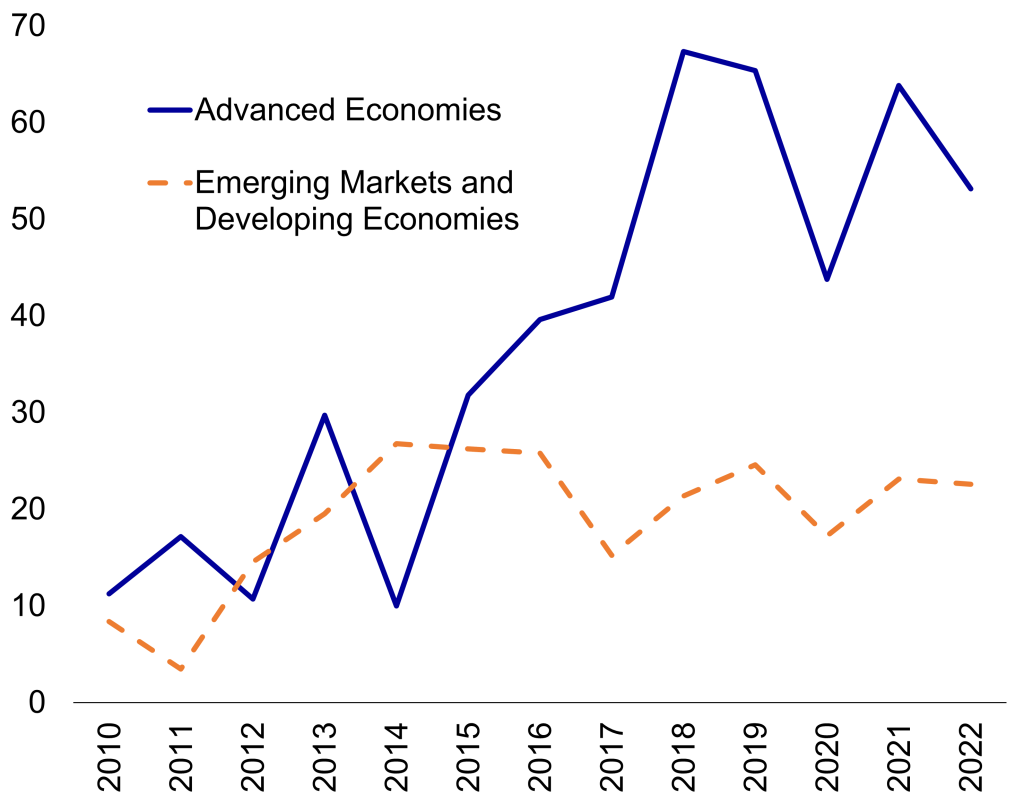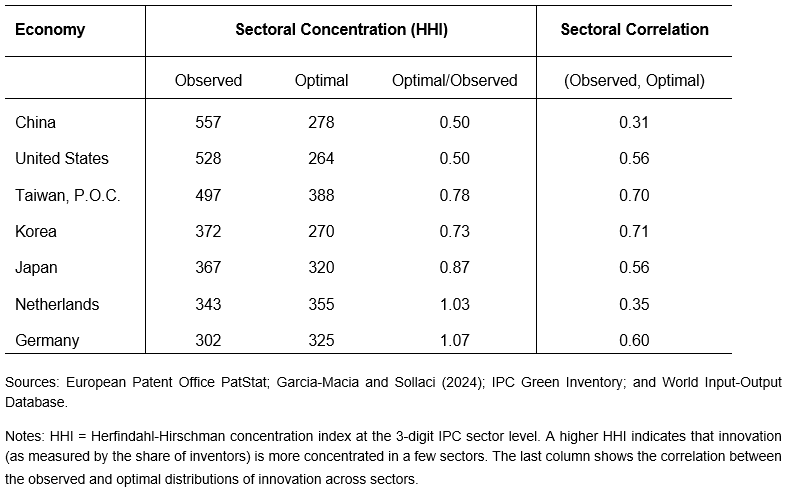

The views expressed are strictly ours and do not necessarily reflect the views of the IMF.
When and how should governments use industrial policy to direct innovation to specific sectors? Using a model of innovation in multiple economic sectors, this brief shows that supporting innovation in specific sectors is only preferable to sector-neutral support under restrictive conditions—when externalities are well measured (e.g., reducing greenhouse gas emissions), targeted sectors generate high knowledge spillovers to the domestic economy (typically in larger economies), and administrative capacity is strong (to avoid resources being misdirected to politically connected sectors). Existing industrial policies in leading economies seem to be directing innovation to broadly the right sectors, but to an excessive degree, especially in China and the United States.
Many countries are ramping up industrial policy to boost innovation in specific sectors in the hope of reigniting productivity and long-term growth, amid security concerns (Figure 1). Recent industrial policy initiatives in advanced economies, such as the CHIPS Act and Inflation Reduction Act in the United States, the Green Deal Industrial Plan in the European Union, the New Direction on Economy and Industrial Policy in Japan, and the K-Chips Act in Korea, as well as longstanding policies in emerging market economies like China, share a strong emphasis on innovation in specific sectors, among other objectives. Most packages include fiscal incentives for innovation in green and advanced technology sectors (such as AI and semiconductors), with a heavy reliance on costly subsidies.
Countries may want to direct the course of their technological innovation for various reasons, including addressing market failures—externalities related to climate and public health, knowledge spillovers to other sectors, supply chain resilience, or national security. However, historical experience suggests that getting industrial policy right is a tall order (IMF, 2024). Whereas policies may help some firms become more productive, they can also lead to an inefficient allocation of resources. Indeed, an abundance of failed programs in economies with strong institutions shows that it is difficult to avoid policy mistakes. Even when projects succeed in transforming industries, they can incur high fiscal costs and, in some cases, generate negative cross-border spillovers.
In a recently published paper (Garcia-Macia and Sollaci, 2024), we develop a framework to assess conditions under which sector-specific fiscal support for innovation (“industrial policy”) is preferable to sector-neutral support (“horizontal policy”). The framework builds upon a model of innovation with a network of sectors that generate knowledge spillovers to each other (Liu and Ma, 2023). In this model, the key benefit of sector-specific support is that it allows to direct innovation towards sectors generating higher knowledge spillovers to other domestic sectors (measured by cross-sector patent citations). This in turn, raises economy-wide innovation, productivity growth, and welfare. We extend the model by considering two practical features of industrial policy implementation. First, governments may make mistakes when implementing policies, or be subject to political capture by certain sectors. And second, governments may follow alternative policy goals, such as supporting green innovation and emission reductions.
Figure 1. Share of Industrial Policies (Percent of total trade policies)

Sources: Juhász et al. (2022), using the Global Trade Alert database.
Model simulations show that a large, advanced economy (for example, the United States), optimally targeting support to sectors with larger knowledge spillovers can increase welfare by almost 3 percent compared to an equivalent amount of sector-neutral support (Figure 2). The welfare gains can rise to up to 6 percent when the government considers green innovation goals and redirects support to sectors with a higher share of green patents. Poor implementation, however, can quickly turn the potential benefits of industrial policies into losses, making sector-neutral support preferable. Benefits are also limited for sectors and economies that rely more on foreign knowledge, which is less likely to be affected by domestic innovation policy.
Overall, the results suggest that industrial policy for innovation can only be beneficial under fairly restrictive conditions. First, externalities must be correctly identified and precisely measured (for example, carbon emissions). Second, domestic knowledge spillovers from innovation in targeted sectors must be strong. And third, government capacity must be high enough to prevent misdirection of resources (for example, to politically connected sectors).
The framework also sheds light on how to optimally allocate innovation inputs across sectors when the above conditions are in place. While greener sectors should receive more support, there is no one-to-one rule, as the degree to which innovation in each sector spills over to other sectors also plays a big role. Conversely, sectors projected to be more exposed to AI do not necessarily warrant stronger innovation support.
Figure 2. Net Gains of Industrial Policy for Innovation, Advanced Economies (Permanent consumption gain (or loss) relative to no industrial policy, percent)

Sources: Díez, Fan, and Villegas-Sánchez (2021); European Patent Office, PATSTAT; Garcia-Macia and Sollaci (2024); Liu and Ma (2023); and World Intellectual Property Organization, Green Inventory.
Notes: Political capture reflects the extent to which subsidies are misdirected to politically connected sectors (proxied by sector markups).
We find that leading economies tend to direct innovation support to broadly the right sectors, with a positive correlation of 0.3-0.7 between the actual (observed) distribution and the optimal distribution implied by the model. However, the intensity of industrial policies, as reflected in the concentration of innovators in certain sectors, is excessive in most economies, and particularly so in China and the United States. In those economies, scaling back the intensity of industrial policies in some sectors could reduce misallocation and increase productivity growth.
Overall, the results suggest governments should be cautious. Even as multiple social goals—most prominently emissions reductions—call for higher innovation in some sectors than others, implementing industrial policies effectively is challenging. It requires sufficient information—including on the nature of market failures and structure of the economy—, administrative capacity, and influence over global innovation flows. Governments deploying industrial policies should strengthen technical capacity to vet subsidized projects, establish clear benchmarks, conduct exhaustive assessment of fiscal costs and risks, recalibrate support as conditions change, and foster competition.
Table 1. Optimality of Existing Industrial Policies for Innovation, Select Economies

Diez, Federico, Jiayue Fan, and Carolina Villegas-Sanchez. 2021. “Global declining competition?” Journal of International Economics (132).
Garcia-Macia, Daniel, and Alexandre Sollaci. 2024. “Industrial Policies for Innovation: A Cost-Benefit Framework”, IMF Working Paper 2024/176
Liu, Ernest, and Song Ma. 2023. “Innovation Networks and R&D Allocation.” NBER Working Paper 29607
IMF. 2024. “Expanding Frontiers: Fiscal Policies for Innovation and Technology Diffusion”. April 2024 Fiscal Monitor, Chapter 2.
Juhasz, Reka, Nathan Lane, Emily Oehlsen, and Veronica C. Perez. 2022. “The Who, What, When, and How of Industrial Policy: A Text-Based Approach.” Working Paper.